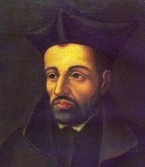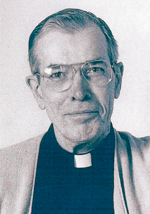Terms: A | B | C | D | E | F | G | H | I | J | K | L | M | N | O | P | Q | R | S | T | U | V | W | X | Y | Z
Terms F
- Faber, Peter
- Faith
- Faith in the Interpretation of Scripture,
The Place of - Fall, The
- Farrell, Walter L.
- Finding God in All Things
- First Principle and Foundation
- First Studies
- First Vatican Council
- Fontbonne, Mother St. John
- Formation, Stages of Jesuit
- Founders of Some Women Religious
Communities - Francis, Pope
- Francis Xavier
- Fundamentum, The
Jesuit Terms F
Faber, Peter (1506-1546)
One of the original companions. saint

His canonization (declaration of sainthood) by Pope Francis on December 17, 2013, helps to emphasize that the Jesuits were founded, not just by Ignatius, but by a group of "companions in the Lord."
Faith
In its fundamental meaning, faith is trust in a person, not belief in an idea or set of doctrines (beliefs). Religious faith, then, is trust in God; and Christian faith is trust in Jesus as the revelation of God in human form (see Incarnation). Traditional Christian teaching on faith includes the recognition that faith is a gift from God.
In the 16th century with Luther and the beginning of Protestant Christianity, one has the doctrines derived from letters of St. Paul of justification by faith alone, not by works. In reaction to this claim, Catholic Christianity asserted the necessity of action (good deeds) and not just faith. In retrospect, it could be said that both sides overstated their case. In the ecumenical theology of today, Protestants and Catholics are often able to understand each other's positions and to reconcile them.
Back to top
Faith in the Interpretation of Scripture, The Place of
Through much of the 20th century, many believing scholars of New Testament as well as those whose approach was neutral or agnostic employed methods of critical interpretation that ignored the faith dimension of individuals and of the community (the church) in the process. But that is changing. New Testament and spirituality scholar Sandra Schneiders, IHM, is one of a growing number of scholars who assert that the faith dimension "must play an integral role in valid interpretation and that this in no way prejudices the scholarly objectivity of [such scholars' work]" (The Revelatory Text).
Thus it is possible to read and to hear Scripture with all of one's self, with one's whole being. In doing this, we overcome centuries of narrowness, of the "reductionism" (e.g., love is nothing but sex; the only valid knowledge comes from rationality, from the head) of the "modern" in every area of life.
Fall, The (Genesis, chs. 3 ff.)
The story of "The Fall" in the early chapters of Genesis (3-7) is not "history" (a category unknown until modern times); it does not teach about some event that happened at "history's" beginning. Rather it teaches something perennially true about human beings (Adam means "the human being")—that we are all implicated in the (moral) evil of the world; by our actions and omissions, which—to put it mildly—are often less than good, we cause that evil. Granted, our freedom and responsibility for the evil are to some extent limited, but our tendency to put the blame for our behavior on others (see Adam and Eve, Genesis 3:12-13) makes it rather clear that we recognize our guilt and try to deflect it. All this is part of what it means to be human—potentially good, with high ideals, but in some mysterious sense that we cannot fathom flawed and imperfect. Some would say it is fear that leads us to evil—fear and the inability to accept and live with our vulnerable condition, our radical dependence and limitation as human beings, as creatures (see Creation).
Farrell, Walter L. (1916-2012)
American Jesuit; "a giant in the Society of Jesus"
 Throughout his long life, Walter Farrell directed his Jesuit brothers and others in the Exercises and shared his knowledge and understanding of the history, institute, and workings of the Society of Jesus. "Walt Farrell had a deep concern for others," said Howard Gray, a younger colleague who worked closely with him at various times--"for their peace of soul, for their wholesome choices, for their authentic prayer, for their good and generous response to what God asked and invited. All of us--each in her or his own way--met the the compassion of Jesus . . . in the way that Walt treated us."
Throughout his long life, Walter Farrell directed his Jesuit brothers and others in the Exercises and shared his knowledge and understanding of the history, institute, and workings of the Society of Jesus. "Walt Farrell had a deep concern for others," said Howard Gray, a younger colleague who worked closely with him at various times--"for their peace of soul, for their wholesome choices, for their authentic prayer, for their good and generous response to what God asked and invited. All of us--each in her or his own way--met the the compassion of Jesus . . . in the way that Walt treated us."
Within the Jesuits, Fr. Farrell served again and again as a wise leader--at West Baden College, as provincial of the Detroit Province, as delegate to General Congregations 31 (1965-66) and 32 (1974-75), as president of the US Jesuit Conference of provincials, as tertian director. He was "a giant in the Society of Jesus."
Finding God in All Things
Ignatian spirituality is summed up in this phrase. It invites a person to search for and find God in every circumstance of life, not just in explicitly religious situations or activities such as prayer in church (e.g., the Mass) or in private. It implies that God is present everywhere and, though invisible, can be "found" in any and all of the creatures which God has made. They reveal at least a little of what their maker is like—often by arousing wonder in those who are able to look with the "eyes of faith." After a long day of work, Ignatius used to open the French windows in his room, step out onto a little balcony, look up at the stars, and be carried out of himself into the greatness of God.
How does one grow in this ability to find God everywhere? Howard Gray draws the following paradigm from what Ignatius wrote about spiritual development in the Jesuit Constitutions: (1) practice attentiveness to what is really there. "Let that person or that poem or that social injustice or that scientific experiment become (for you) as genuinely itself as it can be." (2) Then reverence what you see and hear and feel; appreciate it in its uniqueness. "Before you judge or assess or respond, give yourself time to esteem and accept what is there in the other." (3) If you learn to be attentive and reverent, "then you will find devotion (also called "consolation"), the singularly moving way in which God works in that situation, revealing goodness and fragility, beauty and truth, pain and anguish, wisdom and ingenuity."
First Principle and Foundation (of the Ignatian Spiritual Exercises)
Here are the opening lines of this foundational statement by Ignatius early in his Spiritual Exercises:
God who loves us creates us and wants to share life with us forever. Our . . . response takes shape in our praise and honor and service of the God of our life. All the things in this world are also created because of God's love and they become a context of gifts, presented to us so that we can know God more easily and make a return of love more readily.
(From David Fleming's "Contemporary Reading"; to see the page-long full text, click here.)
There are various interpretations of this "First Principle." Tim Muldoon of Boston College has a reading of it that many are finding helpful for living well in our "postmodern" world. He likes to call the statement "The Fundamentum" (Latin) and sees it not as a doctrinal or rational exercise, but as "an invitation to imaginative play. What, it asks, might it be like if God took the time and care to create my entire life, moment by moment, in order that my acceptance of this creation—and my participation in it—might reflect beauty, as a work of art reflects the creativity of an artist? What might it be like if God were a person who invests in my very being, and places me in a world where I can use everything to achieve [such artistic] perfection? The postmodern person who is wary of arrogant claims to authority and truth can, in good conscience, accept an invitation to exercise imagination."
First Studies
The stages of Jesuit formationThe second stage of a Jesuit's formation and education, consisting of two years of philosophy studies and a year of theology, while living in a Jesuit community at a university.
See also Novitiate, Regency, Theology and Tertianship.
First Vatican Council
See "Council of Constance and Vatican Council I"
Fontbonne, Mother St. John (1759-1843)
Re-Founder of the Congregation of St. Joseph

She was born in Bas-en-Basset, Haute-Loire, on March 3, 1759 of a remarkable Catholic family. Educated by the Sisters of St. Joseph at Bas and Le Puy, she with her sister, Marie, entered the Novitiate at Monistrol where her paternal aunt, Mother St. Francis, was superior. There she received the habit in 1781 and made her vows. She became superior of this convent in 1786.
After the destruction of her convent and the dispersion of the sisters, she returned to the home of her parents. Refusing in spite of threats, insults and persecution of every kind, even physical violence, to attend the Mass of a Constitutional priest, she and her sisters were thrown into the prison of St. Didier and condemned to death, from which they were saved only on the very eve of execution, by the fall of Robespierre.
Inheritor of the blessed traditions of the primitive days of the Institute, and thoroughly imbued with the spirit of the Founders and first Sisters of Le Puy, Mother St. John transmitted those traditions and spirit to a new generation of the Daughters of St. Joseph.
Called by her ecclesiastical superiors from her retirement in her paternal home in 1807 to restore the Congregation in St. Etienne, Monistrol, and finally in 1812 at Lyons, she, by the wish of Cardinal Fesch established the first Mother House of the resuscitated Congregation, of which she was appointed first Superior-General.
Under her wise and holy government more than two hundred houses were, during her life time, established in France, India, England, and other places in Europe and Asia.
In 1836, at the request of Right Reverend Bishop Rosati, she sent six sisters to make a foundation in his Episcopal city of Saint Louis, Missouri, from which establishments have sprung, either directly or indirectly, nearly all the houses of the Sisters of St. Joseph in North America.
Worn out by labor and suffering in the furtherance of God's kingdom and the interests of her Institute, Mother St. John, on November 22, 1843, died at the Mother House of Lyons.
From a pamphlet of unknown authorship
Formation, Stages of Jesuit (early)
The stages of Jesuit formation
The stages of Jesuit (early) formation are Novitiate (2 years), First Studies (3 years), Regency (2-3 years), Theology (3 years), and Tertianship (several options like 2 summers, 1 semester or the better part of a year).
Founders of Some Women Religious Communities
See Women Religious Communities, Founders of Some.
Francis, Pope
Francis Xavier
See Xavier, Francis and St. Francis Xavier: A Contemporary View of His Life and Work by Debra Mooney, Xavier University
Fundamentum, The
See First Principle and Foundation
